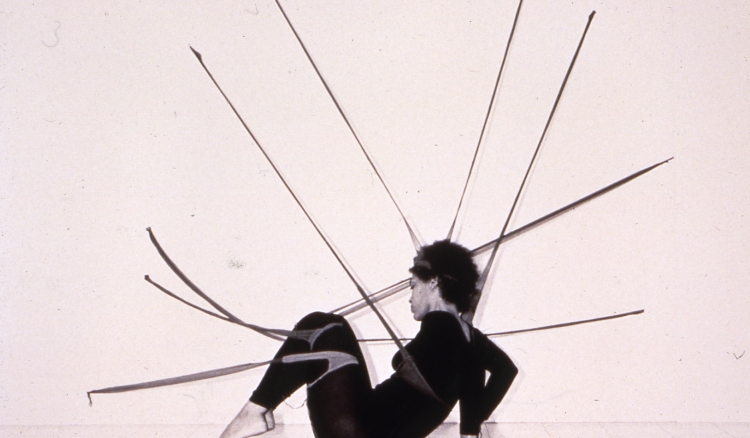 In the fall of 2017, DePaul Art Museum will feature work and documentary photography from Chicago-born artist Senga Nengudi, including "R.S.V.P. sculptures activated by the artist in Performance Piece-Nylon Mesh and Maren Hassinger, Pearl C. Wood Gallery, Los Angeles, 1977," which shows Nengudi activating one of her sculptures. (Photograph © Harmon Outlaw, Pearl C. Wood Gallery, Los Angeles)
In the fall of 2017, DePaul Art Museum will feature work and documentary photography from Chicago-born artist Senga Nengudi, including "R.S.V.P. sculptures activated by the artist in Performance Piece-Nylon Mesh and Maren Hassinger, Pearl C. Wood Gallery, Los Angeles, 1977," which shows Nengudi activating one of her sculptures. (Photograph © Harmon Outlaw, Pearl C. Wood Gallery, Los Angeles)
Unfinished dreams of architecture and art, and pantyhose sculptures that stretch and change like the body, are among the works on display this fall at DePaul Art Museum. The museum will host the first Chicago solo exhibitions for two under-recognized women artists - Senga Nengudi and Ângela Ferreira - from Sept. 7 to Dec. 10.
Senga Nengudi: Improvisational Gestures
Yes, those are pantyhose you see stretched across the gallery walls of DePaul Art Museum. The sculptures are by Chicago-born artist and pioneer of performative art, Senga Nengudi.
"Senga Nengudi is one of the most important American artists of the past 50 years, yet she is still under-recognized," says Julie Rodrigues Widholm, director and chief curator of the DePaul Art Museum. "Her work continues to be relevant as we think about the body, identity and ways art can be innovative and connect people."
The touring exhibition is co-organized by Museum of Contemporary Art Denver, and the Gallery of Contemporary Art at University of Colorado, Colorado Springs. Once installed, Nengudi's sculptures mimic the female form but are stretched, pulled and twisted into distended proportions. Nengudi was inspired by her experience of motherhood and depicts the elasticity, fragility and strength of the body, says Widholm.
Born Sue Irons in 1943, the artist spent her early childhood in Chicago. She was raised and educated in Los Angeles and Pasadena, California, then spent an influential year in Tokyo where she studied noh and buto theatre performance styles. The ritual of theatre and the everyday routine of putting on pantyhose merge in her sculptures. "There is a hybrid, intercultural dialog in the work about inclusiveness and bringing people together," says Widholm.
The work is also connected to Nengudi's perspective as a black woman artist in the 1970s. As part of a radical black avant-garde that included contemporary artists David Hammons and Maren Hassinger, Nengudi lived in New York City and had a solo exhibition in 1977 at the pioneering Just Above Midtown Gallery in Harlem.
The exhibition is co-curated by Windgate Research Curator Elissa Auther of the Museum of Design, and Nora Burnett Abrams of MCA Denver.
Ângela Ferreira: Zip Zap and Zumbi
Architecture, art and history will intersect in "Ângela Ferreira: Zip Zap and Zumbi." DePaul Art Museum Director and Chief Curator Julie Rodrigues Widholm is organizing the artist's first U.S. solo exhibition in conjunction with the Chicago Architecture Biennial.
"Mies van der Rohe's modernism is synonymous with Chicago architecture," says Widholm. "Ângela Ferreira's work offers a unique post-colonial perspective on this familiar subject, while connecting Chicago to a global conversation around the history and politics of architectural forms and materials," Widholm adds.
Ferreira's work mines the complex historical relations that link African indigenous culture, slavery and European modernism. In this exhibition, Ferreira brings together two projects that were never built: Mies van der Rohe's 1913 commission to construct a private museum and house in the Netherlands; and Portuguese architect Pancho Guedes' 1990s design for Zip Zap Circus School in Cape Town, South Africa. The exhibition includes documentary photographs, architectural drawings and a physical structure, which will become a platform for performances and community gatherings.
DePaul Art Museum is a neighborhood anchor site for the 2017 Chicago Architecture Biennial. Ferreira's research-based investigations tap into the biennial theme, "Make New History." The Chicago Architecture Biennial's mission is to provide a platform for groundbreaking architectural projects and spatial experiments that demonstrate how creativity and innovation can radically transform our lived experience. More information about the biennial and the exhibition is
available on the DePaul Newsroom.
The museum is located at 935 W. Fullerton Ave. Hours are 11 a.m. to 7 p.m. Wednesday and Thursday; 11 a.m. to 5 pm. Friday, Saturday and Sunday. The museum is closed Monday and Tuesday. Admission is free. Additional information at
http://museums.depaul.edu or 773-325-7506.